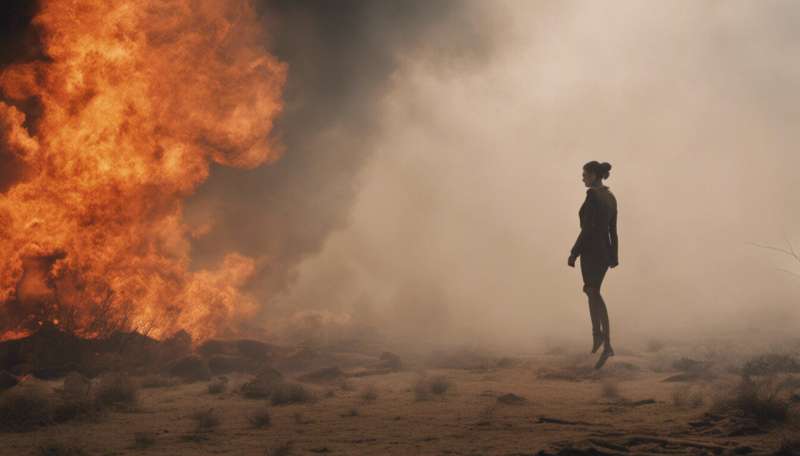Family violence can include fire threats and burning—we can do more to protect women

Using fire and burning, and threats to burn, as part of family violence is more common than many people realize. These tools and tactics are used to coercively control a partner or ex-partner.
Recent legal cases highlight the issue. As one of several acts of family violence against his partner, Brett doused her in diesel and set her hair alight. Similarly, one of Michael's acts of violence against his partner was to splash her with turpentine and threaten to "watch her burn".
Other acts of family violence include burning the survivor's clothing or her furniture.
Yet the threat of fire and burning isn't routinely considered by police and family violence safety services in their risk assessments and safety planning for women who have experienced family violence.
How do perpetrators use fire and burning?
After separation, abusive partners sometimes use fire to punish their partners for leaving them. The time soon after separation is particularly risky for survivors.
Rowan Baxter set alight and killed Hannah Clarke and their children soon after they separated. Similarly, recently separated Doreen Langham and her ex-partner Gary Hely died in a house fire. The coroner found Hely intentionally lit the fire.
Burns can easily be explained away as an accident, especially to those who are not aware of the connections between family violence and the use of fire and burning. This is particularly a concern where the injured woman is unable to tell her story.
Using, or threatening to use, fire is so dangerous because once ignited it spreads easily. It can cause extreme damage, pain, and trauma and, if the woman survives, the impact of injuries can be lifelong.
The use of fire and burning has long been identified as a form of family violence in South Asian countries. In India, for example, a very high proportion of deaths from fire are acknowledged as likely to be associated with family violence. Kerosene burning is considered a unique form of family violence in India.
However, burn-related violence against women and girls has been reported from countries across the world, regardless of national income. Perpetrators of burn-related violence are mostly the partners or ex-partners of injured women.
We need to collect better data
Australia has been slow to recognize and address the link between family violence and burning or threats to burn. This is, in part, due to limited data collection.
One small Australian study is the exception. This study conducted at the Royal Darwin Hospital, found women were more likely to be burnt, or were threatened with burning, during interpersonal violence, compared to men. Over 80% of the victims who suffered burns in this context required surgery, with many requiring skin grafts.
However, there's more we can do right now. Existing burns data held in emergency clinics across Australia should be analyzed to identify the links. This would provide a greater understanding of how common this form of family violence really is.
Assessing the threat
We should develop our risk assessment tools so those who provide support to survivors of family violence—such as police, health workers and family violence support workers—recognize fire and burning threats.
Threats to cause harm are recognized in Australian risk assessment tools but they do not consider fire and burning threats. For example, while threats to cause harm are recognized in Victoria's Multi-Agency Risk Assessment and Management Framework, fire and burning threats are not mentioned.
Improved recognition of the risk of fire, burning and threats to burn may have positive implications for safety planning and prevention. This might include arranging alternative housing, upgrading smoke alarms and disposing of fire accelerants.
Notably, in risk assessments undertaken by police before Doreen Langham's death, fire threat was not identified. However, her ex-partner, Gary Hely, had previously been investigated for setting fire to another ex-partner's home just five years earlier.
If Hely's suspected fire setting had been identified as a risk factor, the history might have been uncovered and more appropriate safety planning undertaken. This might have saved her.
Fire services have an important role
Australian fire services could play an enhanced role in preventing, recognizing and responding to fire related family violence. We could model the approach of England, where fire services have been part of the family safety response for more than ten years.
English fire service representatives contribute to family violence risk assessments and are represented in high-risk teams working with survivors to keep them safe. English fire services also provide enhanced home fire safety checks for those who are identified to be at risk.
Australian fire services do not collect data that allows identification of connections between fire and family violence. Collection of this type of data would be useful in improving understanding, recognition and prevention of family violence related fire incidents. The Victorian fire service, for instance, doesn't include intentional arson deaths when publishing statistics on arson deaths. Yet this is important information.
An enhanced role for fire services would require employees receive family violence training so they can recognize family violence, know how to properly secure any potential crime scene and how to respond to, and work with, survivors. Fire service staff should also have access to mental health support after attending family violence related fires.
Fire services aren't currently part of Australia's family violence safety system, but including them could save lives.
Provided by The Conversation
This article is republished from The Conversation under a Creative Commons license. Read the original article.![]()





















